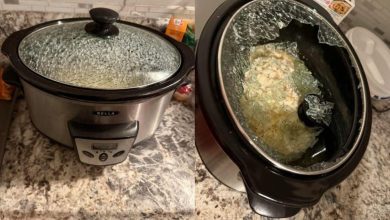How Long Does Tuna Salad Really Last in Your Fridge? Here’s What the Experts Want You to Know

Tuna salad is a beloved classic for many, a go-to comfort food that often sparks warm memories. This delightful mix of canned tuna, creamy mayonnaise, and crisp additions like celery or onion is quick, satisfying, and easy to whip up. It evokes images of relaxed Sunday lunches, sunny childhood picnics, and even those late-night trips to the fridge for a comforting bite.
ADVERTISEMENT
However, this seemingly innocent and delicious dish can become a health risk if not handled with proper care. As we get older, understanding and practicing food safety becomes incredibly important for our well-being. That simple bowl of tuna salad could pose a serious danger if it’s not stored correctly.
ADVERTISEMENT
So, just how long can you safely keep tuna salad in your refrigerator? Let’s dive into the details.
ADVERTISEMENT
Tuna Salad Is Perishable: A Food Safety Essential
The moment you open a can of tuna or prepare a fresh batch of tuna salad, a countdown begins. Tuna salad is categorized as a perishable food, meaning it’s highly susceptible to the rapid growth of bacteria that can cause illness.
The “Danger Zone” for Bacteria
Bacteria thrive and multiply rapidly in temperatures between 40°F and 140°F (4°C and 60°C). This range is often referred to as the “danger zone.” If your tuna salad has been left out at room temperature for more than two hours, it’s generally no longer safe to eat. And if it’s a particularly warm day, that safe window shrinks even more.
“Even one summer picnic with forgotten tuna salad can lead to a trip to the ER,” warns food safety consultant Linda Strauss. She also emphasizes, “Older adults are especially vulnerable to complications from foodborne illnesses.” This highlights why vigilance is key, especially for those who are more susceptible to the severe effects of food poisoning.
Safe Storage Rules Everyone Should Follow
To enjoy your tuna salad without any worries, here are the essential guidelines for storing it safely and keeping it fresh:
- Use airtight containers: Opt for containers made of glass or BPA-free plastic that have lids which seal tightly. This helps to keep out air and contaminants.
- Refrigerate immediately: Don’t let your tuna salad sit on the kitchen counter while you finish cleaning up. Get it into the fridge as quickly as possible after preparation.
- Keep it consistently cold: Store your tuna salad in the main section of your refrigerator, where temperatures are more stable. Avoid storing it in the door, as the temperature there tends to fluctuate more frequently when the door is opened and closed.
- Eat within 3 to 5 days: This is the critical timeframe. After five days, even if the tuna salad looks and smells fine, it might not be safe to consume due to potential bacterial growth that isn’t visible or detectable by smell.
- Pro tip: Always label your containers with the date you prepared the tuna salad. This simple habit eliminates guesswork later on and helps you easily track its freshness.
How to Tell If Your Tuna Salad Has Gone Bad
If you’re unsure whether your tuna salad is still good to eat, your senses are your best defense. Pay close attention to these warning signs:
- Sour or funky smell: Fresh tuna should have a clean, mild smell. If you detect any “off,” sour, or unpleasant odors, it’s a clear sign that bacteria have taken hold.
- Slimy or mushy texture: Tuna salad should have a consistent, firm texture. If it appears slimy, overly wet, or mushy, it’s a big red flag indicating bacterial presence.
- Discoloration: Any noticeable changes in color, such as brown or gray streaks, mean it’s definitely time to discard the salad.
“The nose knows,” says retired home economics teacher Gail Patterson. She advises, “If it smells off, I don’t take the chance. It’s not worth the risk.” Trusting your instincts and senses in these situations is crucial for safety.
Food Poisoning Is Serious – Especially for Older Adults
When tuna salad spoils and is consumed, it can lead to unpleasant and potentially severe symptoms of food poisoning. These can include:
- Nausea
- Vomiting
- Diarrhea
- Abdominal cramps
- Fatigue and dehydration
While younger, healthy individuals might experience a miserable day or two of these symptoms, the consequences can be much more severe for seniors or those with compromised immune systems. For these vulnerable groups, food poisoning can lead to hospitalization, prolonged recovery periods, and other serious health complications.
“It’s not worth gambling with your health over a few scoops of salad,” cautions Dr. Kenneth Lee, a respected nutrition and food safety researcher. His advice is straightforward and vital: “When in doubt, throw it out.” This simple rule can save you from a lot of discomfort and potential danger.
The Bottom Line: Enjoy Tuna Salad Safely
Tuna salad is undoubtedly a tasty, protein-rich, and incredibly convenient meal option. However, its creamy texture, combined with its seafood base, means it has a relatively short shelf life. Whether you’ve prepared it fresh at home or purchased it pre-made from a store, it’s essential to take these safety precautions seriously.
The Safe Tuna Salad Checklist:
- Refrigerate within 2 hours of preparation or purchase.
- Store in an airtight container to maintain freshness and prevent contamination.
- Keep it consistently below 40°F (4°C) in your refrigerator.
- Eat within 3–5 days of making or opening.
- Discard leftovers if unsure about their freshness or if they show any signs of spoilage.
Don’t rely on outdated habits, a simple “sniff test” as your only guide, or wishful thinking when it comes to food safety. Modern food safety guidelines have been developed for very good reasons – and consistently following them is the best way to protect yourself and your loved ones from foodborne illnesses.
Stay Safe, Stay Nourished
Whether you’re making a single serving for lunch or preparing a larger batch to last you through the week, always treat tuna salad with the care it deserves. Following these simple steps goes a long way in ensuring your kitchen remains a safe place and your body stays healthy.
After all, a good meal should always nourish you and bring comfort – not make you sick. What are your favorite ingredients to add to tuna salad?




